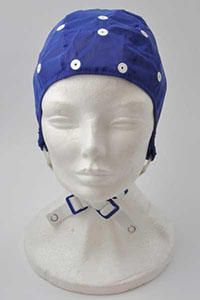Electroencephalography (EEG)
- Definition
- Description
- Preparation
- Risks
- Results
Electroencephalography, or EEG, is a neurological test that uses an electronic monitoring device to measure and record electrical activity in the brain.
The EEG is a key tool in the diagnosis and management of epilepsy and other seizure disorders. It is also used to assist in the diagnosis of brain damage and disease (e.g., stroke, tumors, encephalitis), mental retardation, sleep disorders, degenerative diseases such as Alzheimer's disease and Parkinson's disease, and certain mental disorders (e.g., schizophrenia, autism).
Electroencephalography should be administered and interpreted by a trained medical professional only. Data from an EEG is only one element of a complete medical and/or psychological patient assessment, and should never be used alone as the sole basis for a diagnosis.
For the test, the patient lies on a bed or comfortable chair and is asked to relax and remain still during the EEG testing period. An EEG usually takes no more than one hour. During the test procedure, the patient may be asked to breathe slowly or quickly; visual stimuli such as flashing lights or a patterned board may be used to stimulate certain types of brain activity. Throughout the procedure, the electroencephalograph machine makes a continuous graphic record of the patient's brain activity, or brainwaves on a computer screen. This graphic record is called an electroencephalogram.
The sleep deprived EEG uses the same equipment and procedures as a regular EEG. Patients undergoing a sleep deprived EEG are encouraged to stay awake the night before.
In an ambulatory EEG, patients are hooked up to a portable cassette recorder. They then go about their normal activities, and take their normal rest and sleep for a period of up to 24 hours. During this period, the patient and patient's family record any symptoms or abnormal behaviors, which can later be correlated with the EEG to see if they represent seizures.
Individuals on medications that affect the central nervous system, such as anticonvulsants, stimulants, or antidepressants, could or not be told to discontinue their prescription for a short time prior to the test (ask your doctor). Patients may be asked to avoid food and beverages that contain caffeine, a central nervous system stimulant. However, any such request should be cleared by the treating physician. Patients may also be asked to arrive for the test with clean hair free of spray or other styling products.
Patients undergoing a sleep deprived EEG may be asked to remain awake the night before their test.
If the patient has suspended regular medication for the test, the EEG nurse or technician should advise him when he can begin taking it again.
Being off medication for one-two days may trigger seizures. Certain procedures used during EEG may trigger seizures in patients with epilepsy. Those procedures include flashing lights and deep breathing. If the EEG is being used as a diagnostic for epilepsy (i.e., to determine the type of seizures an individual is suffering from), this may be a desired effect, although the patient needs to be monitored closely so that the seizure can be aborted if necessary. This type of test is known as an ictal EEG.
In reading and interpreting brainwave patterns, a neurologist will evaluate the type of brainwaves and the symmetry, location, and consistency of brainwave patterns. He will also look at the brainwave response to certain stimuli presented during the EEG test.
"Normal" brainwave patterns vary widely, depending on factors of age and activity.
A trained medical specialist should interpret EEG results in the context of the patient's medical history, and other pertinent medical test results.
